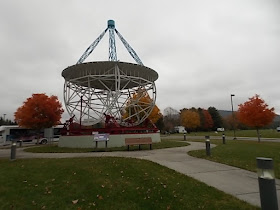What does one do with a six year-old boy who has been enduring virtual classes for the past two months, and then has a misfortune to have his fall break occur on a week that is cool and wet? Take him to a cave, of course! And under the current weather conditions, the cave is warmer than the outside air. That makes it all even better and a sure choice for a day's activities for our grandson Nathan. We were also fortunate that it Meramec Caverns is commercially owned- had it been state operated it would have been closed because of the coronal virus. And to be clear, our tour group in the cave was small and most wore masks. It was possible to keep our distance from the other small family group. We also noticed staff sanitizing the hand rails through out the cave.
The above tableau is what we saw shortly after we entered the cave with our guide. History has it that Jesse James knew this cave fairly well. During the Civil War he was part of a Confederate guerrilla group who blew up a Federal powder mill in in the cavern. Later he used the cave for a hideout for his men and horses to conduct their nefarious activities. In 1933 Lester Dill discovered the five upper levels of the cave. Further explorations revealed 26 miles of underground passages. By the way, the Meramec River runs through the first floor.
Using colored lights certainly creates some special awesome effects on the cave formations. The above picture was taken in the Echo Room, located on the third floor of the cave. The colorful formations are reflected in a crystal clear pool.
The above picture was taken in the Theater Room, and again colorful lights are used to show off "deep stone" draperies which are 70 feet tall, 60 feet across, and 35 feet thick. This was at the end of the tour when we could sit in the seating provided and view a dramatic light and musical presentation.
Unlike other caves we have toured, Meramec Caverns is a fairly easy place to tour what with wide walkways and easy inclines- except for the walk up a stairway of fifty some steps to the Wine Room. Pictured above is a wine table propped up with a long brace. It has a couple of wine bottles sitting atop it. According to our guide, it is the "only completely natural three-legged onyx table known" The room also has one of the two largest ragonites in the world. Ragonites are a carbonate mineral formed under water. This area of the caverns was a natural cavity filling with water over millions of years which also produced the necessary chemistry for the formation of stalagmites that resemble clusters of grapes. Our grandson seemed to enjoy the tour, the hour and half walk burned up some of his energy and he had the opportunity to chatter with another young child on the tour. Attending school virtually has given him very little opportunity to connect socially with other children his age.

















































